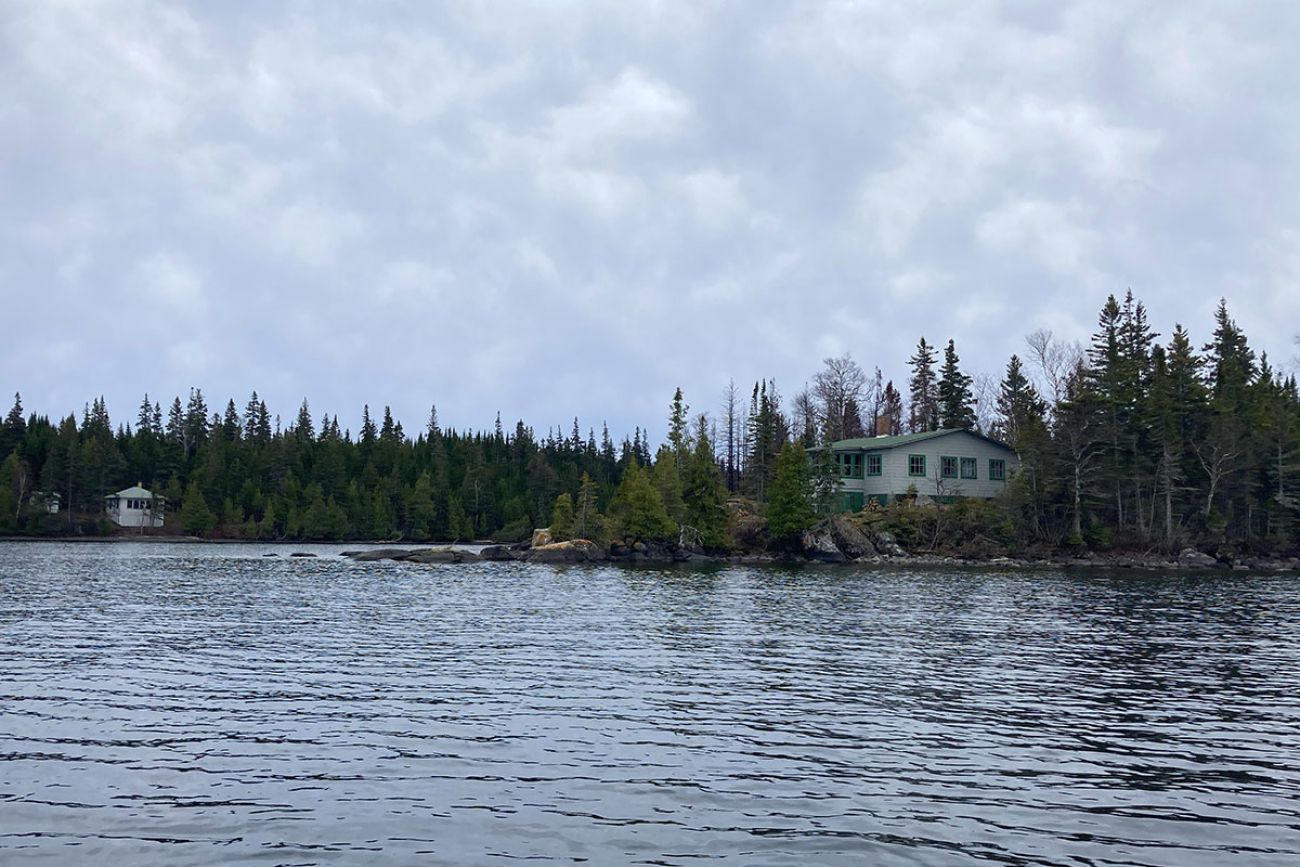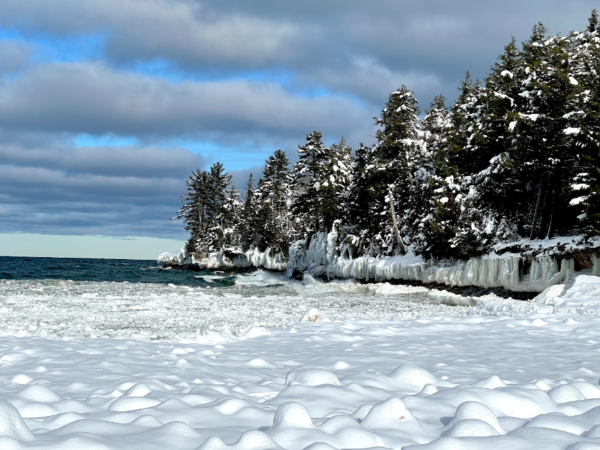
By Kelly House, Bridge Michigan
The Great Lakes News Collaborative includes Bridge Michigan; Circle of Blue; Great Lakes Now at Detroit Public Television; and Michigan Radio, Michigan’s NPR News Leader; who work together to bring audiences news and information about the impact of climate change, pollution, and aging infrastructure on the Great Lakes and drinking water. This independent journalism is supported by the Charles Stewart Mott Foundation. Find all the work HERE.
ISLE ROYALE — Fifty-six miles seaward of the Upper Peninsula, Chris Gale lashes his boat to a faded wood dock and walks a mossy path to the cabin his family built in the 1930s, just before this Lake Superior archipelago became one of America’s most remote and wild national parks.
Though his great-grandfather sold this 2-acre property to the U.S. government soon thereafter, 73-year-old Gale has been coming to the wood-framed, four-room cabin on one of Isle Royale’s surrounding islands summer after summer for most of his life.
The dock, he said, is a “portal” to memories of summer parties with the many families who used to summer at Isle Royale, and a dozen that still do. To days spent navigating misty coves and evenings surrounded by black-and-white family photographs, heirloom fishing gear and a model wooden ship, tossing driftwood on a big stone fireplace. With no electricity or modern plumbing, or a cell phone signal to reach the outside world.
“To this day,” said the retiree from Calumet, “if I can’t get to sleep, I think about Isle Royale.”
Gale has collected those experiences thanks to a lifetime lease his family negotiated when it sold the island property to the U.S. Park Service. After those generations died, subsequent agreements have allowed descendants to remain to present-day.
But time may soon be up.
After a decade of debate between cabin users and those who object to their exclusive hold on public property, park officials are crafting long-term plans for the roughly 200 rustic cabins, outhouses, park buildings and other structures that speckle the shores of Isle Royale and its out-islands. That includes reconsidering the deals giving the families special access.
Organized as the Isle Royale Families and Friends Association (IRFFA), those who still vacation at the cabins hope to maintain their access. But public lands advocates argue that would defy the contracts their ancestors signed, and set a dangerous precedent for privatization of public lands.
“They’re not private cabins that people own that they’re being thrown out of,” said Marvin Roberson, a forest ecologist with the Sierra Club Michigan Chapter. “The public has owned those cabins for 75 years and has not been able to use them.”
And with dozens of historic cabins and outbuildings located in federal wilderness that the law defines as “untrammeled by man,” the National Park Service must first decide whether those dwellings should continue to exist at all.
A compromise, and a warning
Today’s battle has been brewing for eight decades, ever since the park’s 1940 founding as part of a nationwide push to expand protection of public lands.
Fearing their summer haven would fall victim to logging and mining, some Isle Royale property owners had approached government officials with the idea of turning the archipelago into a state or national park.
The federal government agreed to take on the more than 200-square-mile Isle Royale and the islands around it, said Seth DePasqual, the park’s cultural resources manager, on the condition that its ownership would be all or nothing. If the fishing families and summer vacationers wanted to keep industry off the land, they too would have to vacate.
But then came budgetary constraints and compromise, DePasqual said. With limited money to buy island properties, the government began offering life leases to cabin owners in exchange for a lower price, over the objections of the park’s inaugural superintendent, George Bagley.
“He warned this was going to be a big problem down the road,” DePasqual said.
“Prescient, right?”
Then came the 1964 Wilderness Act, followed two years later by the Historic Preservation Act — two sweeping federal laws that offered some conflicting priorities.
The Wilderness Act called for federal protection of wilderness areas “without permanent improvements or human habitation,” while the Historic Preservation Act was intended to preserve “all usable elements of the Nation’s historic built environment.”
Isle Royale contains both wilderness and historic buildings, often in the same place.
Ninety-nine percent of the park’s landmass is now federally-protected wilderness or potential wilderness — a term that refers to land that is intended to gain wilderness status once conflicting uses, such as residential buildings, are eliminated.
Lawmakers who passed the Wilderness Act knew about the long history of human presence — from logging and grazing to Native American habitation and summer cottages — on Isle Royale and many of the other lands they aimed to protect, said Jay Turner, a Wellesley College professor who has studied the landmark law.
Lawmakers designated those areas as wilderness nonetheless, “with the assumption that they would ‘rewild’ over time,” Turner said.
And for a time, the park’s staff viewed their directive as clear: “Any structure was not compatible with wilderness,” according to Liz Valencia, Isle Royale’s interpretation and cultural resources chief.
As leases ended or their holders stopped returning to the islands, the park service would demolish vacant homes, or let the harsh northern winters reclaim them.
But those efforts slowed after the park service struck a new deal with leaseholders in 1977, another compromise.
Under the deal, the park service issued permits that allowed leaseholders’ children to keep using the cabins. After that generation began dying, the park began offering yearly “volunteer-in-park” (VIP) agreements that allowed remaining family members to stay in the cabins in exchange for their efforts to maintain the structures or do other historic preservation work.
Chris Gale, who has such an agreement, spent this spring repairing the engine of a 1940s-era wooden fishing boat and re-roofing a building on his family’s former property.
In the interim, another complexity: The Historic Preservation Act and the passage of time have turned the cabins into historic structures. That obligates the park service to consider how its actions would impact them. And it could justify leaving them standing, even in the wilderness.
In a treatise on Lake Superior’s Apostle Islands, environmental historian William Cronon called the practice of removing historic structures from wilderness areas a “carefully contrived illusion” of a land devoid of human influence.
“No erasures should be the rule,” Cronon wrote, “except where absolutely necessary.”
The Isle Royale families argue that saving the cabins, boathouses and other buildings would preserve the island’s cultural history: In their view, the structures are rare examples of the ways immigrant fishermen, wealthier vacationers, religious communities and back-to-the-land residents coexisted in one of America’s most hard-to-reach places in the early 20th century. Because families are not allowed to alter or add to the structures, they appear frozen in time, their simple construction a testament to the difficulty of building on patches of rock far from the nearest lumber yard.
“It was those harsh and dangerous conditions that brought together people from vastly different socioeconomic environments,” said Carla Anderson, IRFFA’s president and descendant of an island fishing family.
The group has support from the National Trust for Historic Preservation.
“We think it’s both possible, and beneficial, for wilderness and historic and cultural properties to coexist harmoniously,” said Betsy Merritt, deputy general counsel for the trust.
And the park service, guided by the Historic Preservation Act, has signaled at least partial agreement. In 2019, it obtained historic designation for Tobin Harbor, an area on the island’s busy northeastern end that contains a former commercial fishery, a shuttered resort and a host of seasonal cottages, calling the harbor an “unusually high integrity” example of the historic period it reflects.
But nonprofit group Wilderness Watch is pushing for the cabins located within federal wilderness to be demolished or allowed to molder, with no special use by families on the properties that remain standing.
“I certainly sympathize with the families,” said Kevin Proescholdt, the group’s conservation director. But allowing the cabins to stand, he said, conflicts with a Wilderness Act prohibition on permanent structures. There are enough historic buildings in the park’s non-wilderness lands, Prescholdt argues, to preserve history without compromising wilderness.
And Preschold said he fears that making exceptions for the Isle Royale families could set a precedent for more serious private encroachment on public lands.
Such disputes have grown common as life leases end on public lands across the country. One such fight on the Point Reyes National Seashore wilderness north of San Francisco gained national attention when a Koch brothers-affiliated nonprofit backed a small oyster company in its losing battle against shutdown orders.
In other cases, cabin users have found allies in Congress to pass laws ensuring their perpetual use. And at times, deals have been struck to allow some public use while continuing to give families special access.
More often, said Rick Smith, an 84-year-old former parks superintendent who oversaw a high-profile land dispute in the Guadalupe Mountains of Texas, “it ends when the remaining survivors no longer are willing to fight.”
If they remain, who will maintain them?
Budget issues further complicate the debate on Isle Royale. With a national maintenance backlog of $21.8 billion, Valencia said the park service “doesn’t have the funds or all of the expertise” to care for so many buildings on its own.
Family members see that as all the more reason to let them stay. Many of them have spent considerable time and money maintaining the structures.
Carla Anderson’s family spent five years and $30,000 replacing two external walls of the cabin built by her great-grandfather, a Scandinavian immigrant fisherman who made his living on the island.
It was no simple task, with much of the work done by hand because wilderness law prohibits the use of motorized equipment, Anderson said, but “I really feel like this just connects me to my roots in this country.”
The Grand Portage Band of Lake Superior Chippewa, likewise, has deep roots on the island. Seth Moore, the Minnesota-based tribe’s biology and environment director, said Grand Portage is looking to “reassert our historic occupancy,” after losing claim to the island through an 1844 compact with the U.S. government that tribal officials see as coercive and arguably invalid.
If the cabins remain standing, Moore sees them as potentially useful home bases for tribal members visiting Isle Royale.
He understands why the descendants of former cabin owners feel strongly about maintaining special access: Isle Royale’s distant and wild environment, home to wolves, moose, rare plants and some of the country’s darkest night skies, makes it among America’s least-visited national parks, and the one with the greatest frequency of return trips.
It’s the kind of environment that fuels a sense of ownership among visitors, he said. “But I’m not convinced that they have actual ownership.”
What’s next?
The IRFFA families point to the dune shacks of Cape Cod National Seashore as a potential model for the future.
There, the park service allows a designated set of families to continue using some shacks, while nonprofits manage the others, offering programming and overnight rentals.
“Some sort of relationship that would allow others to be involved in maintaining the place, I think, is a good solution,” Anderson said. But she remains opposed to renting the buildings out to overnight guests without oversight to prevent wear-and-tear.
“Whatever the outcome is, you have to understand how fragile these buildings are and how rare they are.”
But Cape Cod is not federally-designated wilderness, said DePasqual, the park’s cultural resources manager, and such an arrangement on Isle Royale could run afoul of policies against commercial use and exclusive occupancy.
In that case, Gale said, he and other IRFFA members want the park service to reconsider what the families see as an arbitrary jurisdictional line between the archipelago’s tamed and wild places. After all, he said, Isle Royale’s growing popularity means the tranquility surrounding Gale Island is interrupted multiple times daily by the buzz of seaplane landings and the blast of ferry horns.
This is allowed because the seaplanes land in water, which isn’t wilderness. And the ferry docks in Rock Harbor, one of the island’s patches of non-wilderness. Many of the Isle Royale cabins sit just outside the boundary.
“There are some disconnects between what we hear and see every day, and whether or not this should be wilderness,” Gale said.
Convincing the parks service to make such a change would be a long shot, requiring action at the agency’s highest levels. And wilderness or not, public lands advocates say they remain opposed to any arrangement that gives anyone preferential access to the cabins.
Roberson, the Sierra Club ecologist, said he agrees that the majority of the island’s cabins should be preserved, even in wilderness. But the way he sees it, opening the cabins up to new visitors only helps expand the pool of people invested in preserving them.
“If the cabins are going to continue to be used,” Roberson said, “use needs to be fairly distributed among the park visitors.”
A draft parks plan hints at the possible changes ahead: Under park officials’ preferred approach for non-wilderness areas, families’ individual VIP agreements would end. The agency would repurpose some cabins as administrative offices, day-use educational buildings, or lodging, and partner with outside groups to preserve historic structures.
Family members could be involved in those partnerships, said Valencia, the park’s cultural resources chief. But they would no longer get exclusive, individual access in return.
“These are really interesting, fascinating pieces of Isle Royale history, and we want to make sure visitors can share in that,” Valencia said. Deciding what to do with the cabins that sit in wilderness, she said, will present “another layer of complexity.”
The draft wilderness plan is due later this year.




